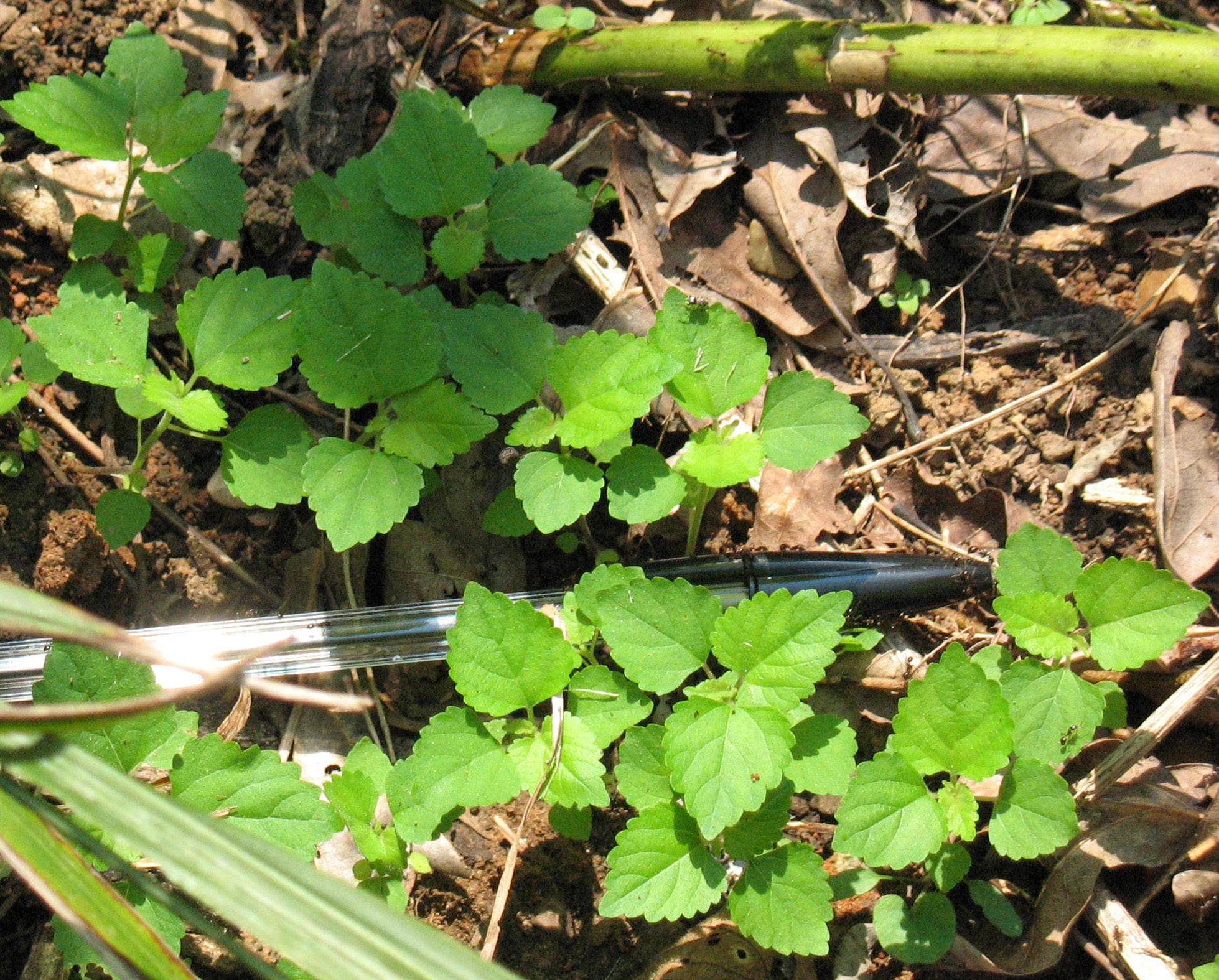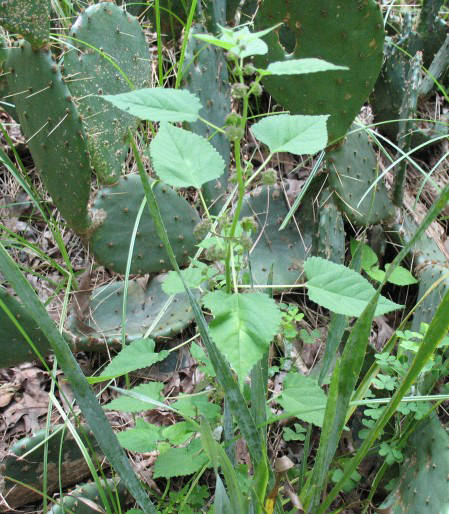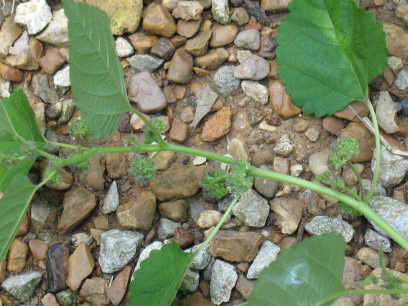Hairy Crabweed



Hairy crabweed (Fatoua villosa), also known as mulberryweed, is an introduced annual in the mulberry family. Hairy crabweed is native to East Asia and was likely introduced to Louisiana around 1964. Other reports indicate that it escaped around New Orleans in the 1950s, perhaps by contaminated equipment brought back to the United States after World War II. Compared with other invasive plants, hairy crabweed is a fairly recent introduction, yet it occurs over much of the United States today. Hairy crabweed seems to avoid detection often until it is well established on a site. This is possibly because of its similar appearance to seedling mulberry trees. In addition, plants can produce seedlings around 1 inch tall, making it difficult to detect while it becomes established.
Description
With the common name of mulberryweed, hairy crabweed is similar in appearance to mulberry trees but with notable differences. Hairy crabweed is an annual whose mature height is highly variable. There have been reports that hairy crabweed is a perennial under greenhouse conditions. Plants will disperse seed at a distance, anywhere from around 1 inch to 3 feet or more. Seedling cotyledons are rounded with an apical notch. True leaves are alternate with serrated margins, rather large, and triangular to cordate in shape. Plants are hairy—including leaves and stems. Plants produce a taproot, and stems are round, with color ranging from green to reddish.
Flowers grow in 1-inch clusters on short stems in the axils of the leaves. Flower clusters range from green to purplish and fade to brown with age. Flowers lack petals. Seeds are small (about 1 millimeter), tan, and oval. Some seeds are forcibly ejected (explosive dehiscence) and can be thrown up to 4 feet as a form of natural dispersal. Seeds germinate in warm weather (60–100°F), maturing within 12 days after reaching the two-leaf stage. This maturity rate makes eradication difficult without persistent monitoring of the site.
Habitat
Hairy crabweed plants prefer moist areas in sun or shade, but mostly shade. Landowners purchasing nursery plants should be cautious. Even though hairy crabweed may not be visible in the container, seeds may be in the soil. Seeds can be thrown into containers by nearby plants and go unnoticed until they germinate. Once in a suitable habitat in the landscape, it will proliferate without eradication. Hairy crabweed adapts to a wide range of habitats, including sun to shade and wet to moderately moist soils. Habitat resources often determine how large the plant will grow, but it tends to produce seed over a wide range of plant sizes—this ensures its persistence on a variety of habitats.
Hairy crabweed has a wetland indicator status of facultative (it can occur in wetlands). It can be very problematic in moist woodlands by outcompeting certain native species, including rare woodland species growing on moist woodland bluffs. However, hairy crabweed does not invade, establish, and persist in dry environments.
Control Methods
Cultural
Since hairy crabgrass weed is adapted to a wide range of habitats, most cultural controls are not effective. Hairy crabweed seeds require light for germination, so landscape fabric or thick mulch layers may help reduce hairy crabweed emergence in landscape beds. Another option is to kill the weed with fire using a flame weeder, such as Red Dragon.
Mechanical
Mowing hairy crabweed is often ineffective or increases the problem. Plants can flower and produce seed at a very small size, easily missed with a mower. If mowing cuts a young stem, it may branch below the cut and produce seed. Digging or pulling plants up with the taproot is effective. When pulling up the plants, minimize disturbance if they are in flower. Disturbance can cause seed to disperse. In addition, mature plants should be placed in a bag or closed container to prevent seed dispersal as the plants are moved. Do not dump mature plants in other areas of the landscape since seeds can cause more problems in the new area.
Chemical
Tables 1a and 1b show common herbicides. Preemergence herbicides must be applied and activated (watered into soil) before seed germination for effective control. Consult herbicide labels to verify that ornamentals or turf can tolerate herbicide before applying it. All postemergence herbicides listed are nonselective. These products will damage other ornamentals if the spray solution contacts desirable plants. Triclopyr can be absorbed by plant roots and can vaporize after applications and damage desirable plants. Nonionic surfactant should be added to postemergence herbicides at the rate of 32 ounces per 100 gallons spray mix. Some glyphosate products contain surfactant in the formulated product and, therefore, do not require additional surfactant.
|
Herbicide |
Trade name/formulation |
Method |
Rate |
|
Flumioxazin |
Broadstar/0.25% |
soil |
150 lb/A |
|
Dimethenamid + Pendimethalin |
Freehand/1.75% |
soil |
100 to 200 lb/A |
|
Indaziflam |
Specticle, Esplanade, etc./0.62 lb ai/gallon 20% |
soil |
6 to 12 fl oz/A or 3.75 to 5 oz/A |
|
Isoxaben |
Gallery/75% or 4.16 lb ai/gallon |
soil |
0.67 to 1.3 oz/A or 16 to 31 fl oz/A |
|
Isoxaben + Prodiamine |
Gemini/3.74 lb ai/gallon |
soil |
44 to 87 fl oz/A |
|
Oxyfluorfen |
Goal, etc./2 lb ai/gallon |
soil |
80 to 160 fl oz/A |
|
Oxyfluorfen + Pendimethalin |
OH2/3% |
soil |
100 lb/A |
|
Oxyfluorfen + Oxadiazon |
Regal 0-0/3% |
soil |
100 lb/A |
|
Oxyfluorfen + Prodiamine |
Biathlon/2.75% |
soil |
100 lb/A |
|
Oxyfluorfen + Oryzalin |
Route/3% |
soil |
100 lb/A |
|
Oryzalin |
Surfian/4 lb ai/gallon |
soil |
64 to 128 fl oz/A |
Table 1b. Chemical control for hairy crabweed (postemergence).
|
Herbicide |
Trade name/formulation |
Method |
Rate |
|
Glyphosate |
Roundup, etc./3 lb ae/gallon |
foliar spot foliar broadcast |
2 fl oz/gallon water or 32 oz/A |
|
Glufosinate |
Finale, etc./3 lb ae/gallon |
foliar spot foliar broadcast |
2 to 3 fl oz/gallon water 96 to 128 oz/A |
|
Triclopyr |
Turflon, etc./4 lb ae/gallon |
foliar spot foliar broadcast |
2% solution or 24 fl oz/A |
References
Neal, J., Chong, J. C., & Williams-Woodward, J. (2017). 2017 Southeastern US pest control guide for nursery crops and landscape plantings. NC State Extension Publications.
USDA, NRCS. (2007, June 27). The PLANTS Database.
The information given here is for educational purposes only. References to commercial products, trade names, or suppliers are made with the understanding that no endorsement is implied and that no discrimination against other products or suppliers is intended.
Publication 3204 (POD-04-24)
By John Byrd Jr., PhD, Extension/Research Professor, Plant and Soil Sciences, and Victor Maddox, PhD, Senior Research Associate, Plant and Soil Sciences.
The Mississippi State University Extension Service is working to ensure all web content is accessible to all users. If you need assistance accessing any of our content, please email the webteam or call 662-325-2262.



